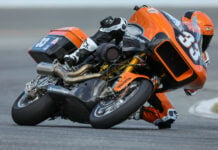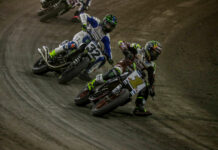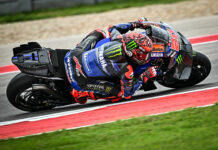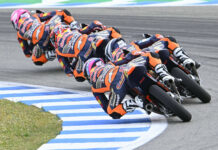From a press release issued by AMA Pro Racing, consisting of a question-and-answer interview with AMA Pro Racing CEO Scott Hollingsworth:
Q: Tell us about the proposed changes you’re announcing for the AMA Chevy Trucks U.S. Superbike Championship.
Hollingsworth: What we’ve announced is a blueprint for the AMA Chevy Trucks U.S. Superbike Championship going forward — our first significant revision in more than a decade. The plan has come together over the past 18 months with input from manufacturers, promoters, fans, tire manufacturers, and the FIM and Octagon, the World Superbike Championship promoting body. It’s a difficult equation to balance with so many competing interests, but we are committed to the continued development of AMA Superbike competition with deeper grids consisting of quality, cost-effective equipment. Fans will benefit from this evolution, and the entire AMA Chevy Trucks U.S. Superbike Championship will benefit from that.
Everyone should recognize that this is the next step in an ongoing process to restructure the AMA U.S. Superbike Championship. In the past two years, we’ve increased purses and redirected them more to the middle of the field, increased our television exposure by approximately 60 percent, improved the quality of the facilities on our schedule and made significant additional commitments to improve safety. It’s now time to improve the professionalism of the series, focusing more on our premier classes and providing fans even more value than they’ve come to expect. Growth over the past several years has been excellent, this blueprint helps ensure growth into the future.
Q: Regarding Superbike technical regulations. You’ve chosen a different path than the FIM and World Superbike, why?
A: For a multitude of reasons. Essentially, each series must respond to the unique characteristics of the market it serves, while recognizing global trends. Although FIM technical regulations are not complete, it seems clear that their approach includes virtually unlimited engine modifications while restricting airflow. The FIM approach makes for easy technical inspection at events — important when traveling the globe from race to race, transporting control pieces, performing teardowns and rebuilds and repacking it all for transport.
However, AMA Pro Racing is not limited in that manner. The technical regulations we’re proposing limit engine modifications, not airflow. With the ability to perform more extensive technical inspections at events, the benefit is engine development programs that are significantly more cost-effective for competitors, a critical element in getting a deeper field of competitive Superbikes.
At the same time, both AMA Pro Racing and the FIM have to recognize the shift in consumer demand to 600cc and 1000cc equipment. Allowing 1000cc multi-cylinder machines that are more restricted than current 750cc multis and 1000cc twins encourages participation by more manufacturers and private teams, because they will be racing equipment available for sale in the showroom.
Q: Do you think the 1000cc multis will be faster than current Superbikes?
A: No, but we do expect them to be competitive. Current Formula Xtreme technical regulations allow greater modifications than what’s proposed for 1000cc multi-cylinder Superbikes in 2003. But there is a balancing act here. Current Formula Xtreme machines can’t get all of the available power to the ground, and aren’t as nimble as Superbikes, meaning they have lower corner speeds and slower lap times. Because of this, it will take some time for teams to develop these 1000cc multis and close the gap on today’s frontrunners. In three to five years, we expect the market will evolve to the point where the entire grid will be composed of this type of equipment.
Q: Some have expressed concern about tire wear on 1000cc multis. How do you respond to that concern?
A: 1000cc multis will have similar horsepower output and weight to the current Superbike and Formula Xtreme race bikes. Tire development has also quickened with the advent of MotoGP where bikes have significantly more horsepower than an AMA Superbike. We’re confident that our tire manufacturers are up to the task.
Q: Why cut the 250 Grand Prix and Pro Thunder classes from the AMA U.S. Superbike Championship?
A: When we examined ways to continue to improve our operations, it became apparent that running six different classes during a race weekend was simply too many. There are many demands placed on operations staff by things like live television, race operations, electronic timing and scoring, safety-related matters including maintaining the air modules in the event of an accident, rescheduling whenever a race is delayed for any reason, and technical inspections. These demands are simply too great for the limited time available during the course of a race weekend. Fewer classes allows us more time to devote to other important concerns, such as allowing more track time for riders who need it and increasing fan access to riders in the premier classes.
And, as we have noted, we are in discussions with our road-racing affiliate, WERA, to continue to operate these classes in hopes that they can once again become a place where young riders learn the craft of road racing on their way to becoming the AMA Superbike stars of tomorrow.
Q: Any indication on how fans will react to moving the 250 Grand Prix and Pro Thunder classes off the program?
A: We’ve actually done some fan research on which classes they enjoy the most. These two classes ranked far below the others. There was also a lot of feedback that said they want to see the top riders have more track time during the weekend–which also validates the increase in double header Superbike races.
Q: So we should expect additional announcements?
A: Yes. We wanted to inform competitors and other stakeholders as soon as possible about the direction we’re heading so they can begin to make plans. But there are further elements that will be addressed. It remains our objective to provide some of our significant independent teams the commercial assistance to make motorcycle racing an economic undertaking, while encouraging their participation in the U.S. Superbike Championship, where competition from factory equipment will likely only intensify. We’ll accomplish this through a combination of commercial programs, rider eligibility requirements and technical regulations for 2004 that will be announced in the coming months.
AMA Pro Racing Boss: Why Rules Will Be Changed And Classes Cut
AMA Pro Racing Boss: Why Rules Will Be Changed And Classes Cut
© 2002, Roadracing World Publishing, Inc.






